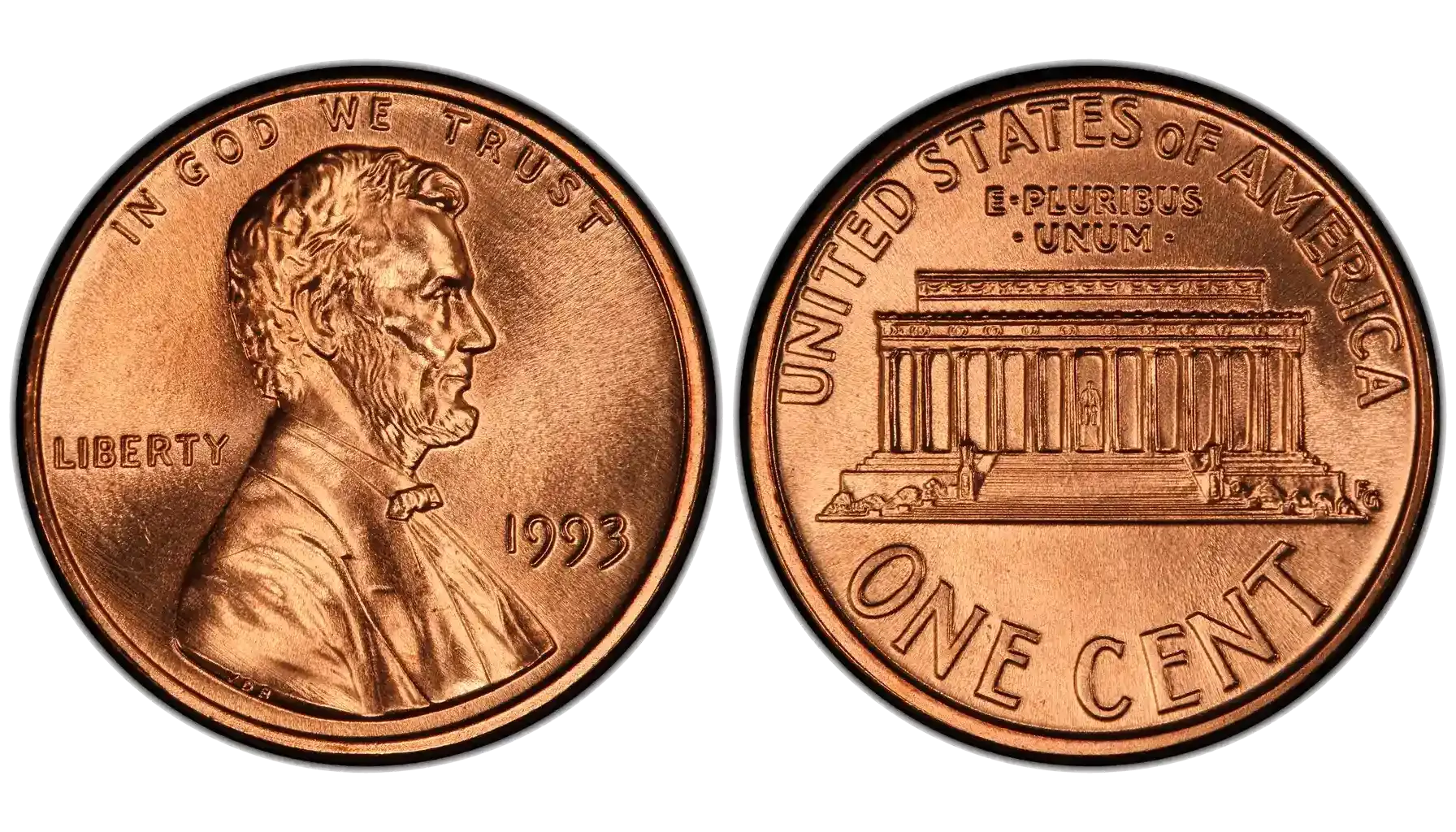Contents:
Most coins minted in 1974 were destined for lunch counters, vending machines, and coin jars—but not all of them stayed ordinary. Among the 1974 dimes, a handful broke the mold. These subtle outliers, often overlooked, can transform a humble ten-cent piece into a collectible worth dozens or even hundreds of dollars.
In this guide, the team of the Coin ID Scanner app will break down what makes the coin mostly common, what makes a few of them rare, and how to confidently identify the difference. Moreover, how much is a 1974 dime worth?
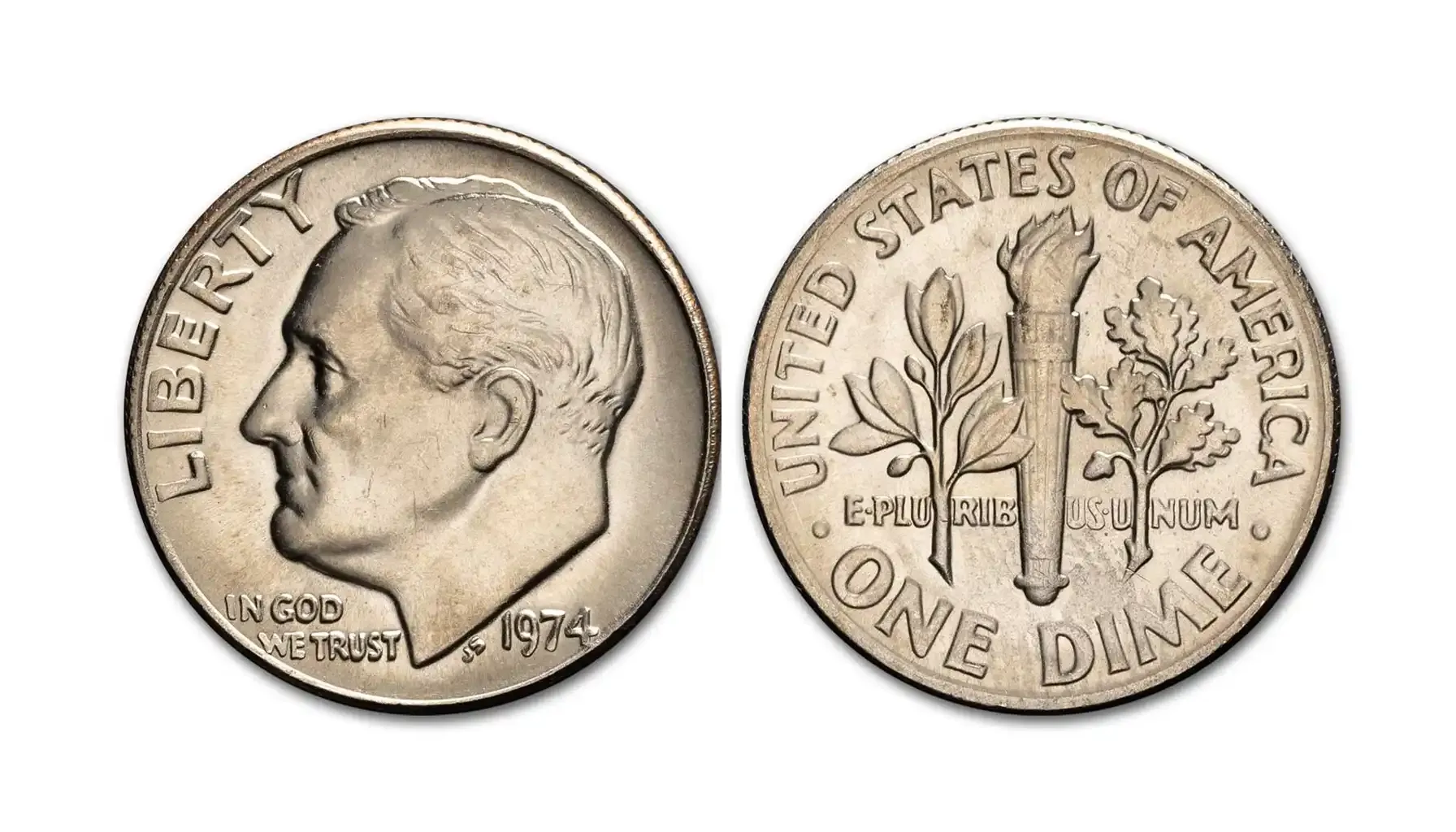
Feature | Specification |
Year | 1974 |
Mints | Philadelphia (1974 dime with no mint mark), Denver (D), San Francisco (S - Proof only) |
Designer | John R. Sinnock |
Composition | Outer layers: 75% Copper, 25% Nickel Core: 100% Copper (i.e. 1974 copper dime) |
Weight | 2.27 grams |
Diameter | 17.91 mm (0.705 inches) |
Edge | Reeded (118 reeds) |
Thickness | 1.35 mm |
Shape | Round |
Strike Type | Business Strike (P, D), Proof Strike (S) |
Mintage Totals | 889,692,568 (P + D) + 2,612,568 (S Proof) |
Silver Content | None – clad composition only |
About the 1974 US Dime
The coin has been a fixture of American currency since 1946, honoring the late President Franklin D. Roosevelt. By 1974, it had become a pocket change staple—reliable, utilitarian, and easily forgotten.
But here’s what you need to know:
Mint | Mint Mark | Mintage | Composition | Typical Dime 1974 Value |
Philadelphia | 1974 no mint mark dime value | 431,540,000 | Cupronickel clad over copper | $0.10 (face value) |
Denver | 1974 D Roosevelt dime | 455,540,000 | Cupronickel clad over copper | $0.10 (face value) |
San Francisco (Proof Only) | 1974 S Roosevelt dime | 2,612,568 | Cupronickel clad over copper | $1–$4 (collector value) |
None of the 1974 Roosevelt dimes were minted in silver—so melt value is not a factor. However, collectors prize uncirculated and proof examples in pristine condition, especially if they contain minting errors.
1974 Dime Value No Mint Mark
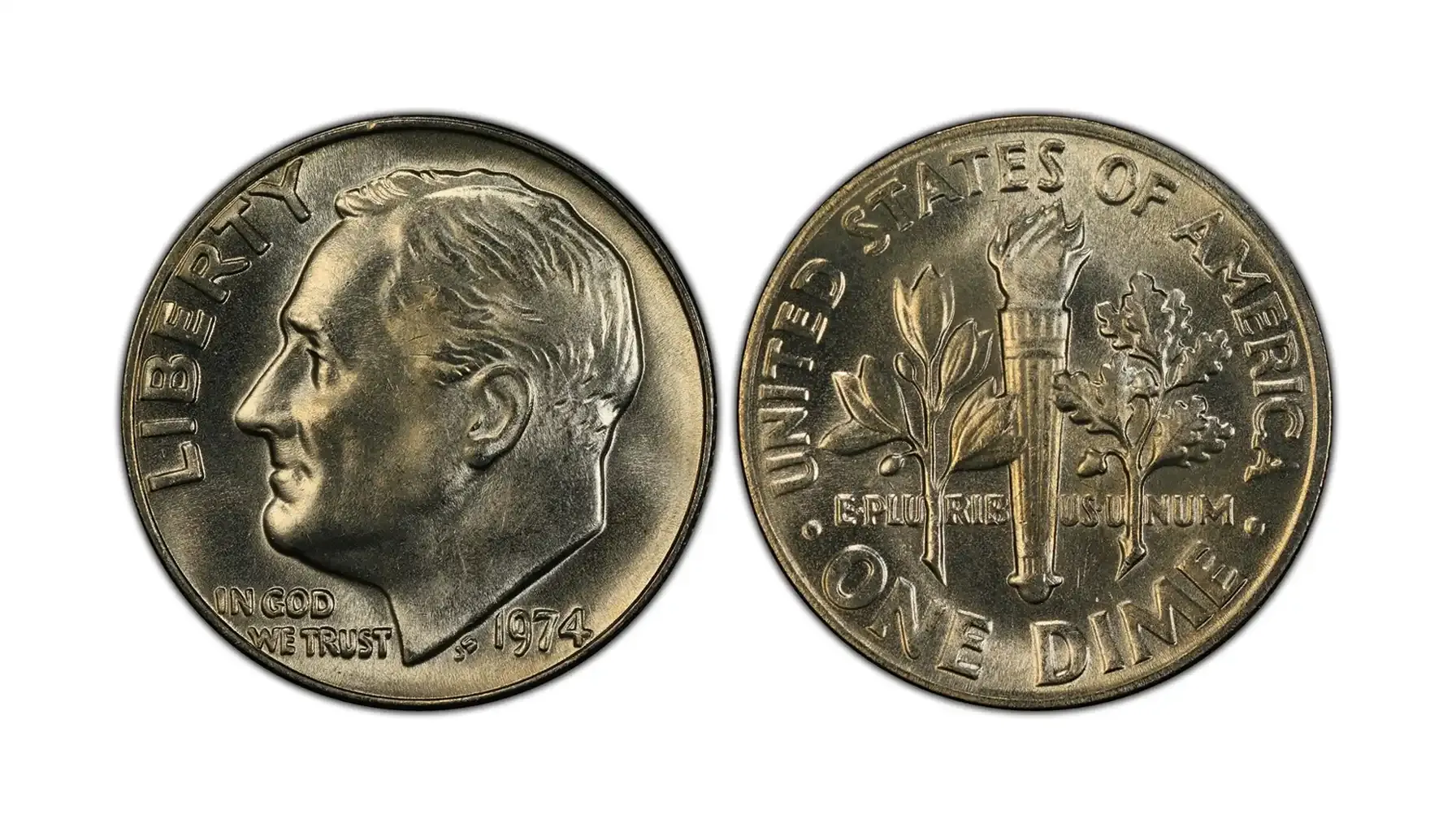
Struck at the Philadelphia Mint.
No mint mark under the date ( = 1974 no mint dime).
Very high mintage: 431,540,000 coins.
Found in nearly all U.S. circulation.
No proof strikes made here in 1974.
What to Look For:
Double die obverse (DDO): subtle doubling in “LIBERTY” and date.
Strong strike quality is rare, as most coins were quickly produced.
Full Torch (FT) designations are uncommon.
1974 Dime No Mint Mark Value:
Circulated: $0.10 (face value).
Mint State (MS 60–63): $0.50 – $1.50.
MS 64–65 (with full details): $2 – $5.
1974 dime no mint mark error coins (e.g. DDO): $20 – $150+ depending on severity and grade.
1974 D Dime Value Today
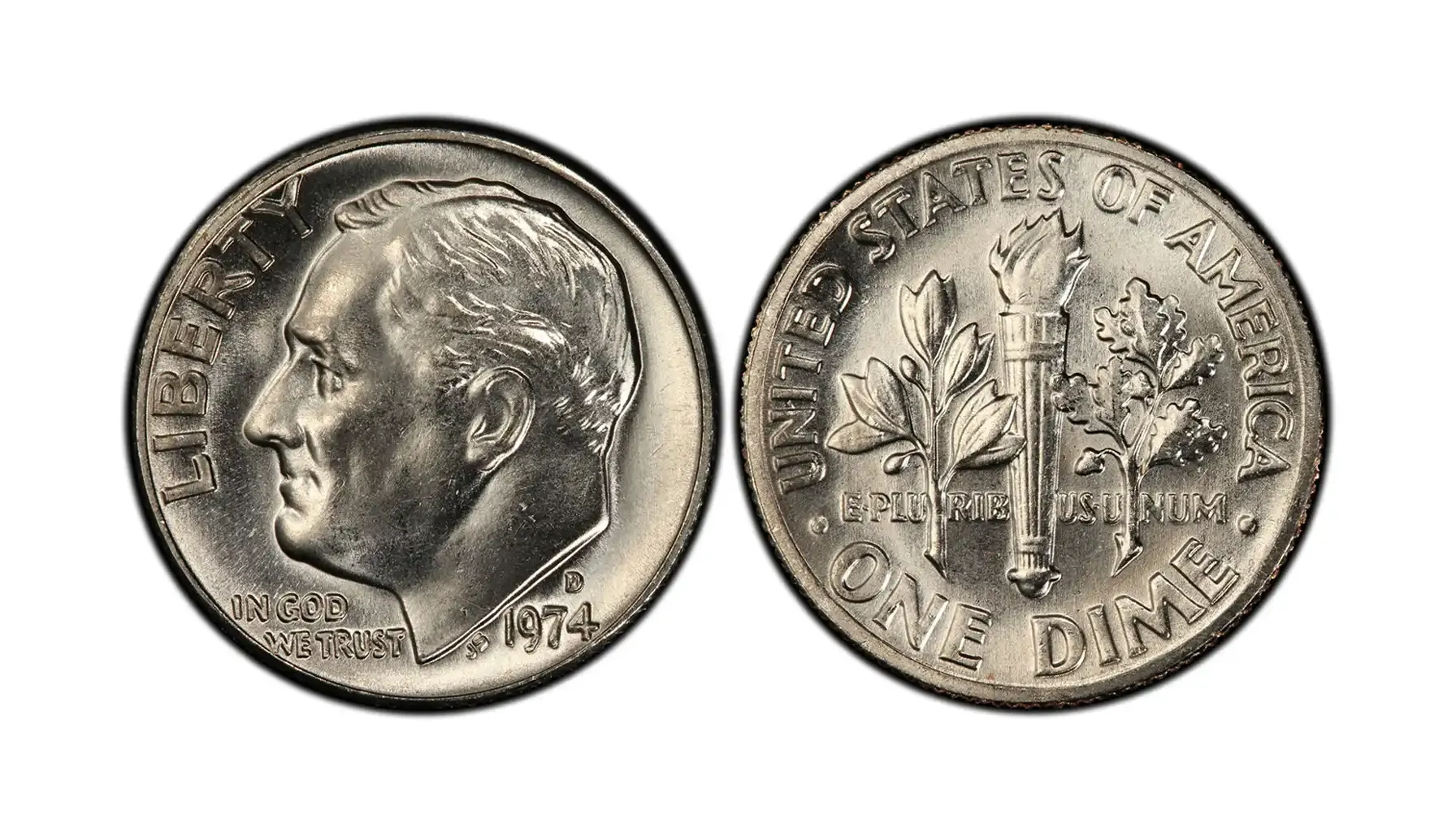
Minted in Denver, identified by a “D” mint mark beneath the date.
Very high mintage: 455,540,000 coins.
Slightly better strike quality than Philadelphia in some cases.
What to Look For:
Off-center strikes and broadstrikes are reported more frequently with Denver coins.
Double die errors are rarer than from Philly but still possible.
Check for unusual planchet flaws or clips.
Here’s the 1974 D Dime Worth:
Circulated: $0.10.
Mint State (MS 60–63): $0.50 – $1.50.
MS 64–65: $2 – $4.
1974 D dime error value: $25 – $200+ depending on type and visibility.
1974 S Dime Value Today
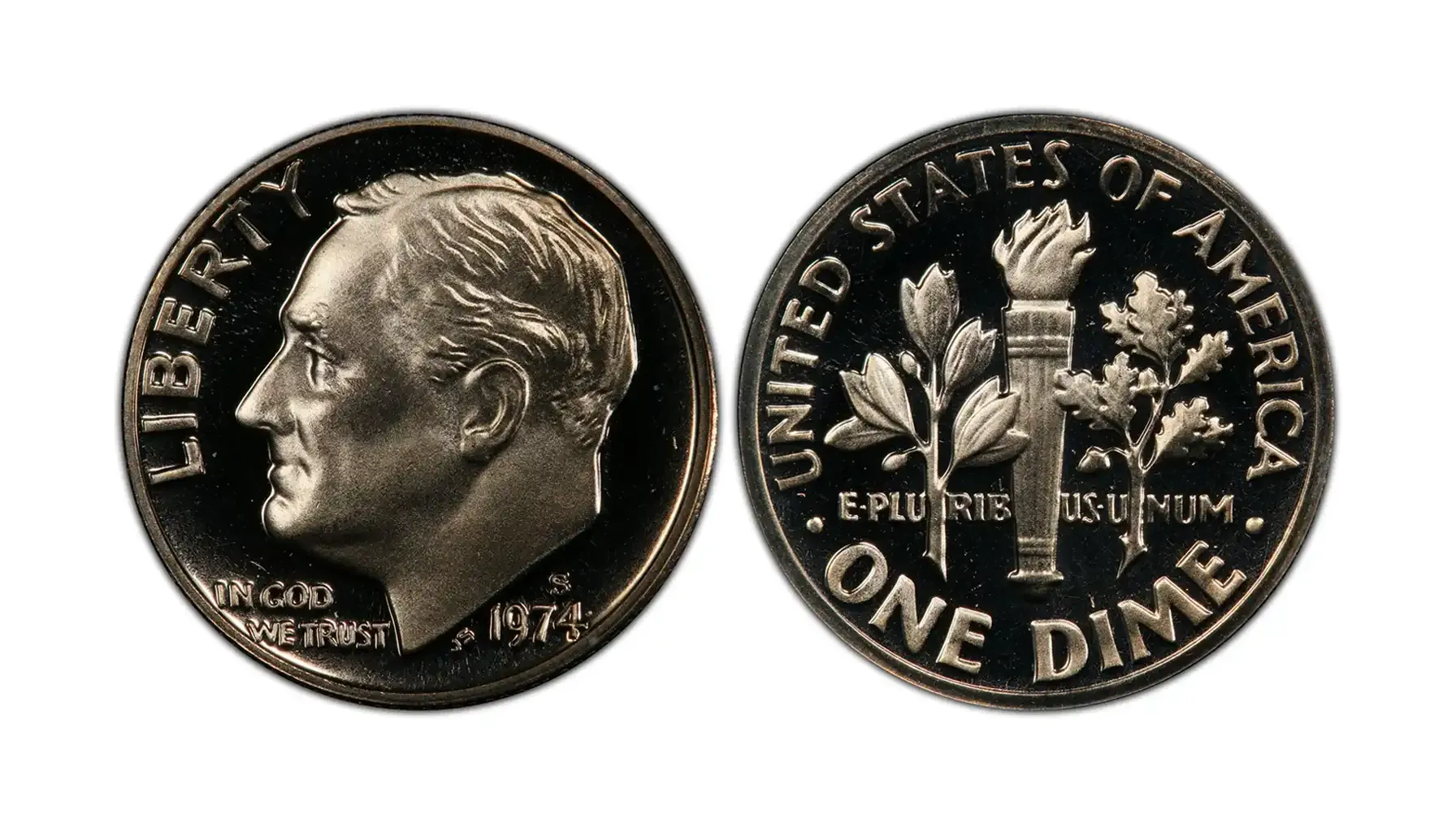
Proof-only coin issued in collector sets.
Identified by a “S” mint mark beneath the date.
Mintage: 2,612,568 - relatively common among modern proofs.
All coins struck with polished dies and special planchets.
What to Look For:
Deep Cameo (DCAM) contrast between mirrored fields and frosted details.
Hairlines or spotting can significantly lower value.
Packaging damage (e.g., from broken proof sets) reduces desirability.
What Is a 1974 Dime Worth with S Mint Mark?
Typical Proof (PR60–PR64): $1 – $3.
High-grade Proof (PR65–PR68): $3 – $6.
PR69 DCAM or better: $10 – $25+ depending on market demand.
Misstruck or damaged proofs: variable value; some fetch premiums as 1974 dime errors collectibles.
1974 Dime Error List with Pictures
Double Die Obverse (DDO)

A popular error among collectors, the double die obverse occurs when the coin’s design is stamped twice in slightly misaligned positions.
Where to check: Look at “LIBERTY,” “IN GOD WE TRUST,” and the date.
1974 dime error value: $25 to over $150, depending on clarity and condition.
Off-Center Strikes
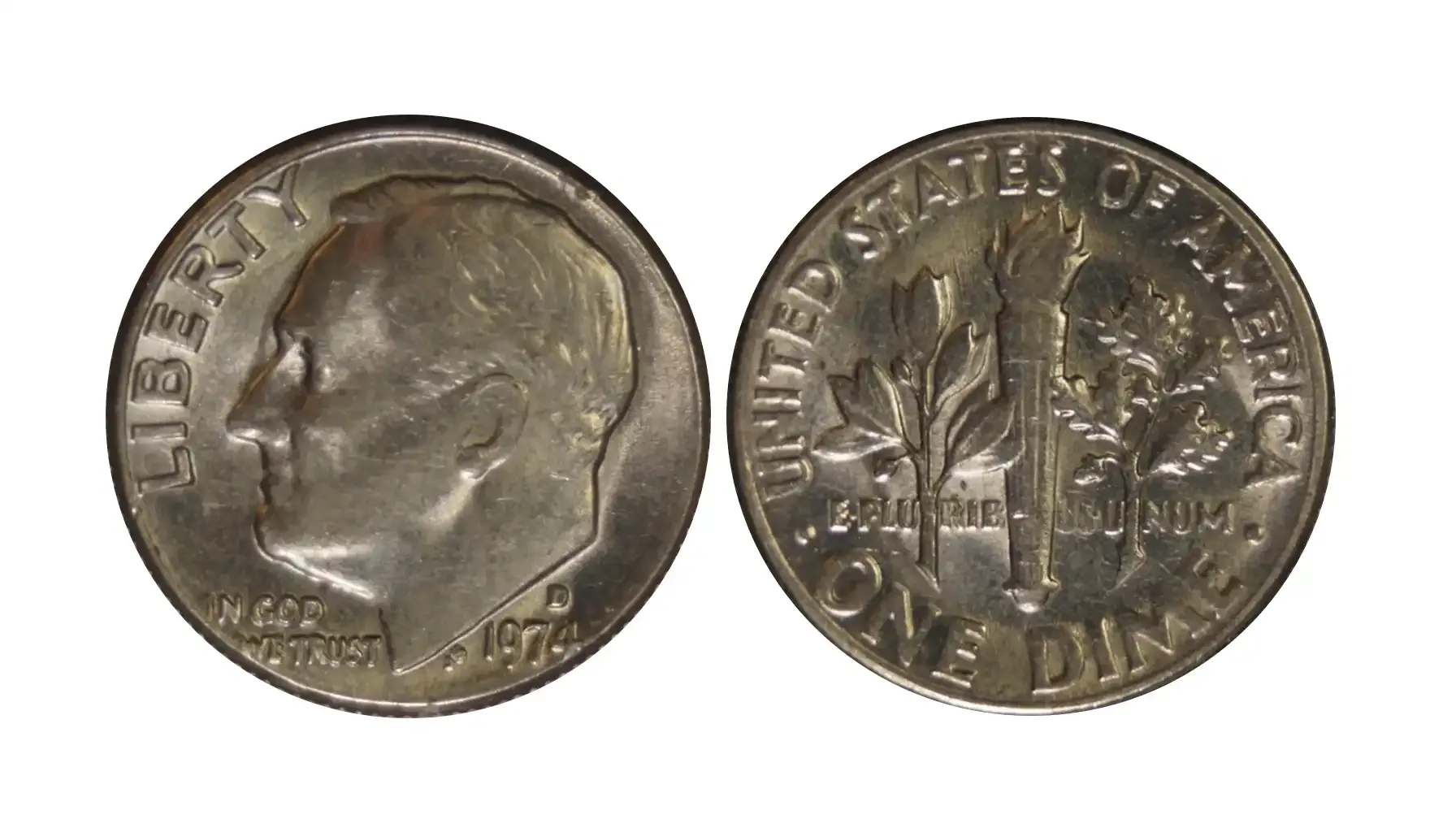
If the blank (planchet) isn’t perfectly aligned when struck, part of the design may be missing—creating an off-center strike.
Visual clue: Part of the coin appears "cut off" or lopsided.
Ideal error: 40–60% off-center with a visible date.
Value range: $50 to $200+
Clipped Planchets
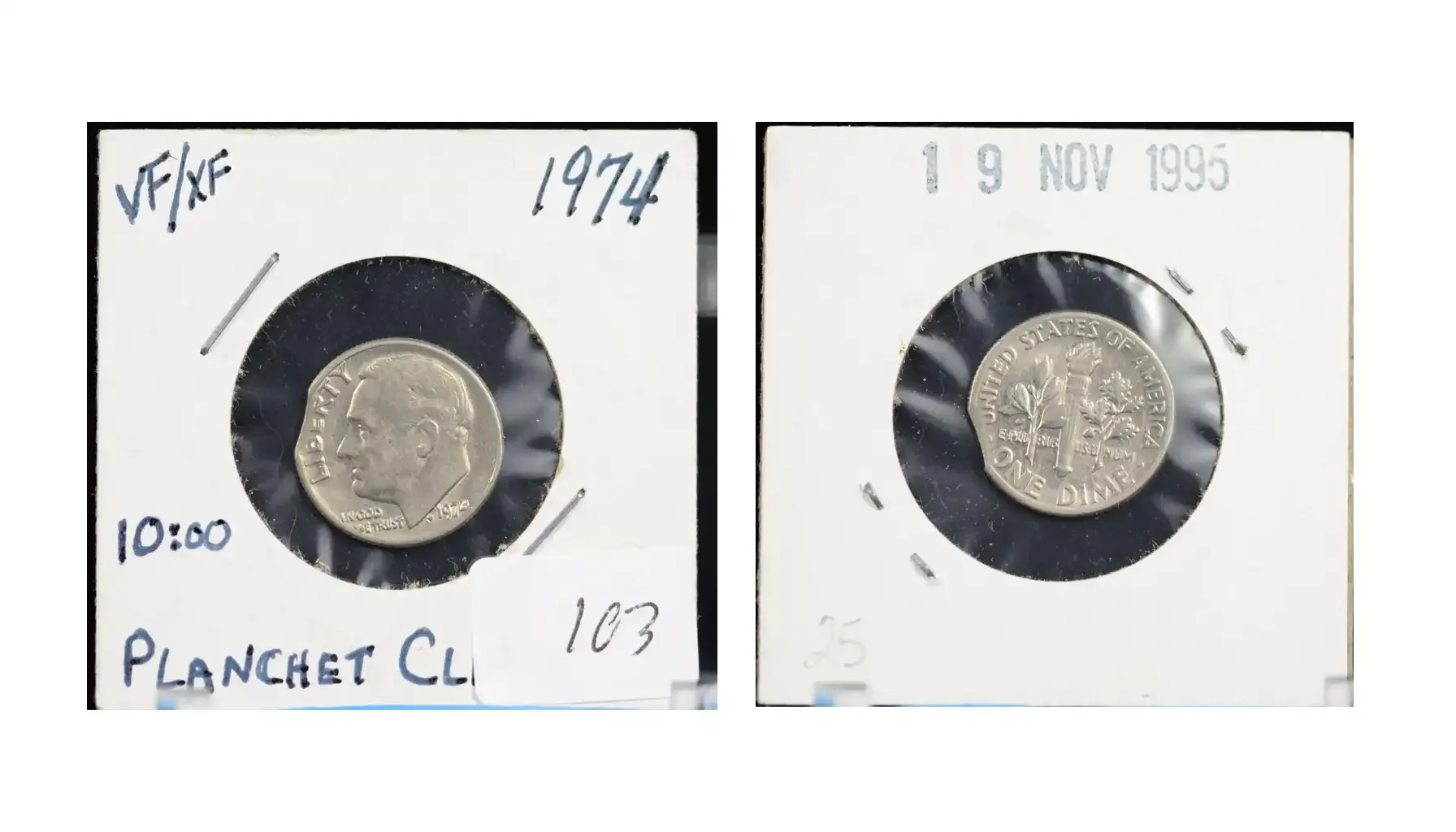
A clipped planchet occurs when a blank is improperly cut, leaving a curved or straight "bite" out of the coin.
Common shape: Crescent-like curve.
Value: Typically $10 to $75
Broadstrike Errors
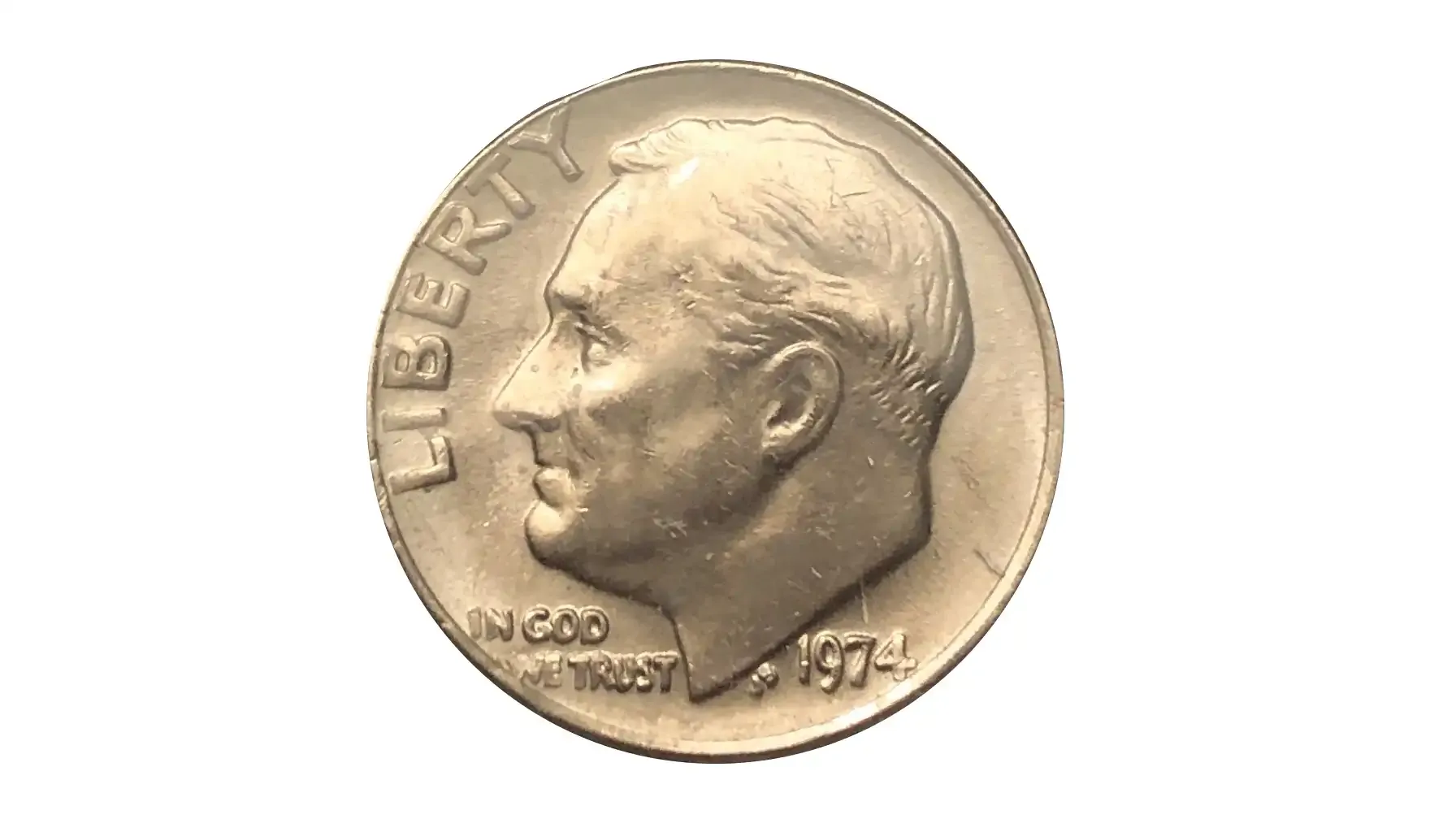
Coins struck without a retaining collar may expand beyond their normal diameter, losing their reeded (ridged) edge.
Look for: A smooth edge with a slightly flattened appearance.
Value: $10 to $40
Wrong Planchet Strikes
One of the rarest and most exciting errors is when a coin is struck on the wrong metal blank—like a penny planchet.
Signs: Smaller diameter, copper coloring, underweight (around 2.5g instead of 2.27g).
Value: $300+ depending on type and condition.
1974 Gold Dime
A 1974 “gold” Roosevelt one is NOT an official U.S. Mint product. However, here's the breakdown of what it might be and how to assess its authenticity and value:
What May It Be?
1. Post-Mint Gold-Plated Issue
Most common explanation.
Regular coins of this type that are coated with a thin layer of gold as a novelty or promotional item.
Often sold by private companies or used as advertising giveaways.
No added collector value of 1974 dime beyond novelty—usually worth 10 to 50 cents.

2. Gold-Toned from Environmental Exposure
Sometimes they develop a gold or yellowish hue due to:
Heat exposure
Chemical reactions (e.g. sulfur or chlorine)
Long-term storage in PVC holders
This is toning, not actual gold.
Again, not rare or valuable 1974 dime unless the toning is naturally beautiful and even—might bring $1–$3 to niche collectors.
3. Wrong Planchet Error (Extremely Rare)
Hypothetically, if a rare 1974 dime was struck on a gold planchet (e.g., meant for a foreign coin), it would be an extremely valuable mint error.
However, no confirmed specimens struck on gold planchets have ever been authenticated by PCGS or NGC.
If you suspect this, get it weighed and professionally graded immediately.
Check | What It Tells You |
Weight | Genuine one = 2.27g. If heavier, plating or wrong planchet possible. |
Edge | Reeding filled or blurred? Could indicate plating. |
Color | Is it bright gold or dull yellow? Bright gold suggests recent plating. |
Certification | If you suspect something unusual, submit to PCGS or NGC for authentication. |
How to Spot Rare Varieties Without Special Tools
You don’t need a lab or a vault to identify a rare piece. Just a few simple tools and a keen eye:
10x Loupe or Magnifying Glass – Check for doubling or micro-errors.
Digital Scale – A genuine 1974 dime should weigh about 2.27 grams.
Lighting and Patience – Good light and slow, steady examination make all the difference.
Keep in mind: Some errors are barely visible to the naked eye but can affect value. You may always refer to the 1974 D dime error list with pictures if you need.
Proof Ones: The 1974-S Edition
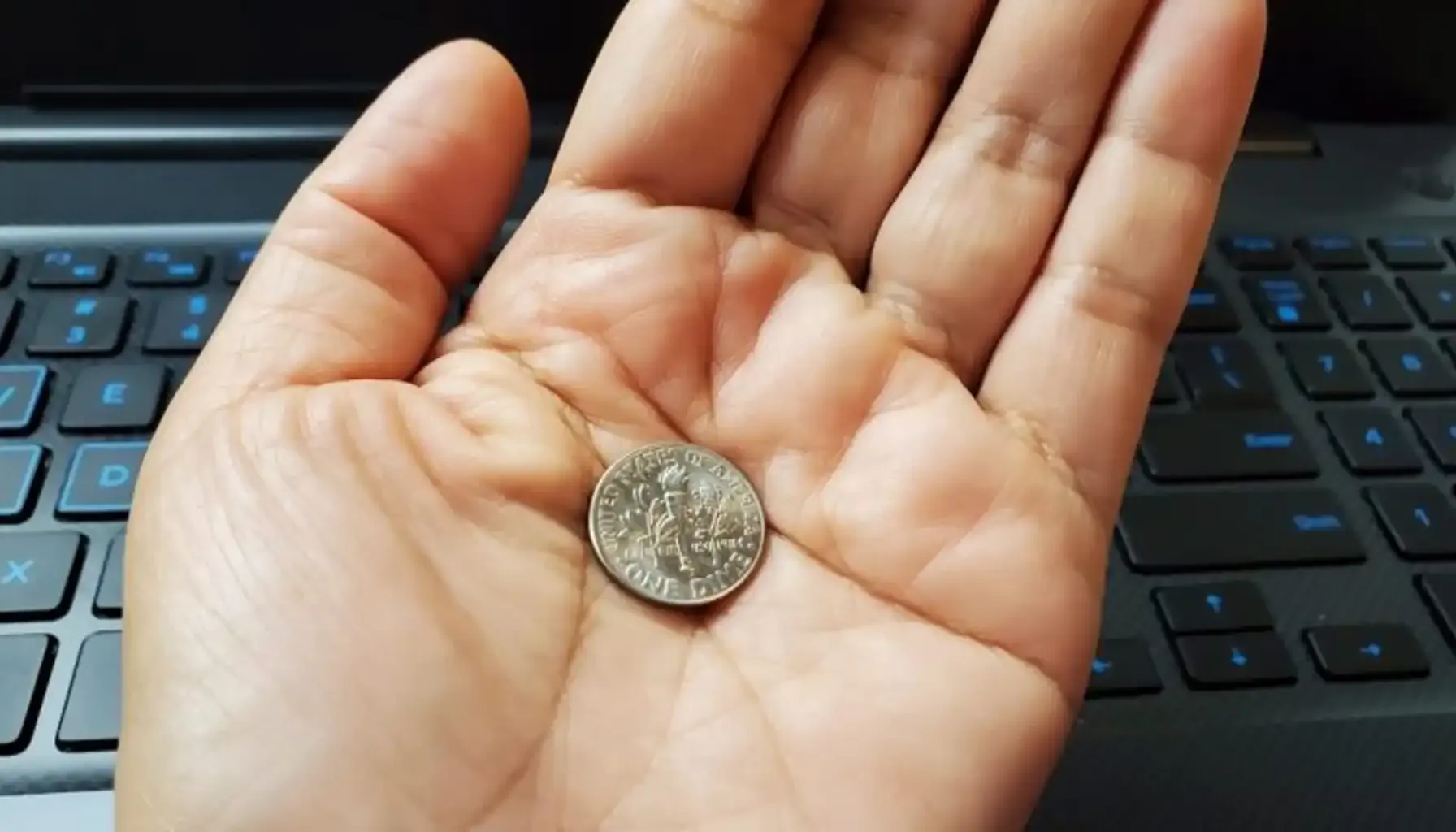
While Philadelphia and Denver struck coins for circulation, San Francisco minted only proof dimes in 1974.
Mirror-like fields with frosted devices
Sharp details and double-struck precision
Cameo or Deep Cameo (DCAM) contrast in high grades
Is a 1974 dime worth anything? These proof coins were sold in sets to collectors and were not intended for circulation. Although common, perfect examples (graded PR69–PR70) can sell for $3 to $25 depending on market demand.
Are They Worth Getting Graded?
That depends on what you find.
When to Grade:
You suspect a rare error (DDO, off-center, wrong planchet).
You have a proof or mint state coin in flawless condition.
You’re planning to sell at auction or to serious collectors.
When Not to Grade:
Your coin is circulated and shows no signs of error.
The value would be less than the cost of grading (typically $25+).
How a Coin ID Scanner App Can Help You
Simply snap a photo of your coin.
The app identifies the type, date, mint mark (e.g., the 1974 dime D mint mark), and other details in seconds.
Works even for worn or partially visible coins.
Useful when verifying how much is a 1974 no mint mark dime worth (other marks as well).
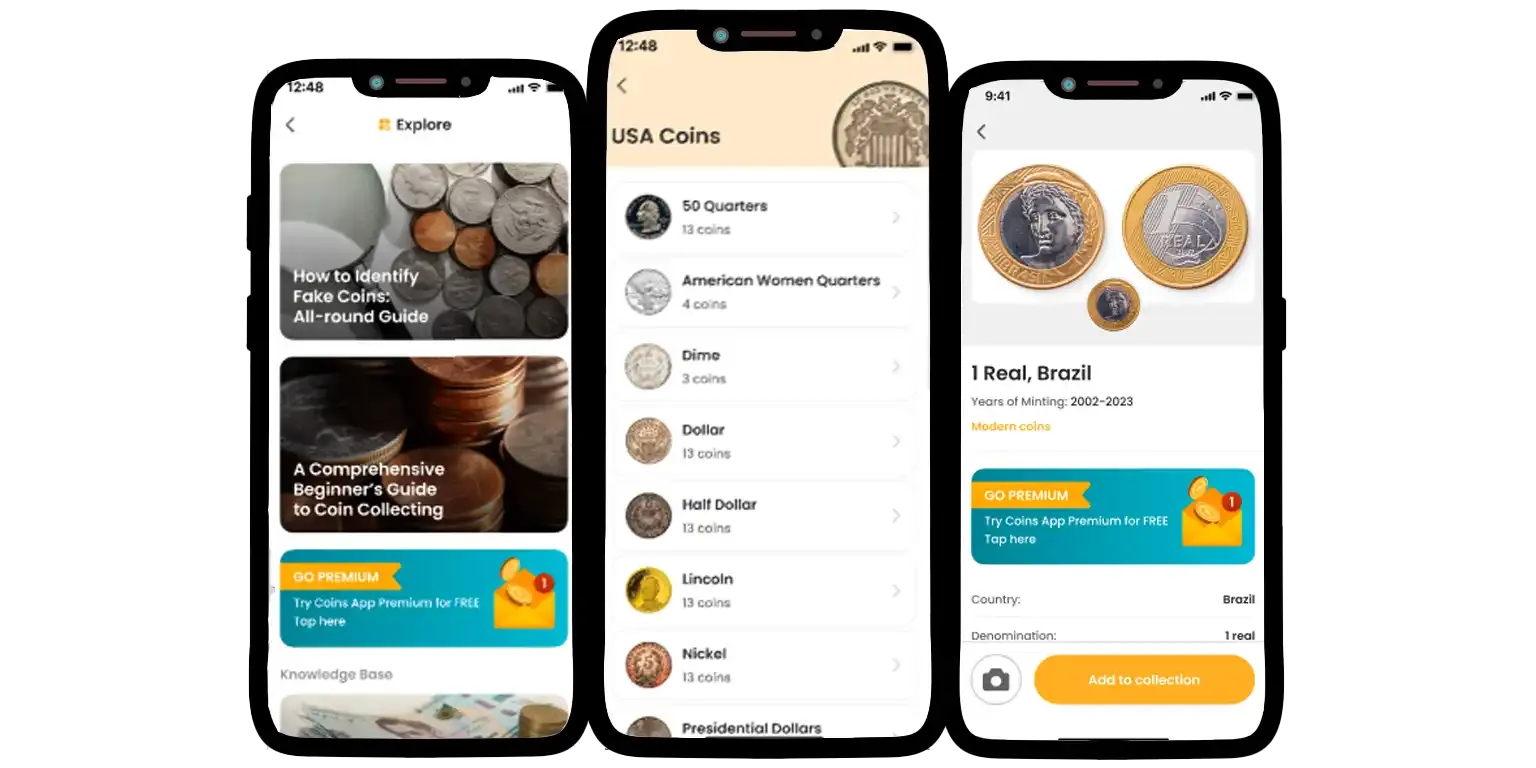
FAQs
Can a 1974 dime be silver by mistake?
No, a genuine specimen cannot be silver under normal minting conditions. The U.S. Mint discontinued the use of 90% silver in dimes after 1964. All from 1965 onward, including 1974, were made using a copper-nickel clad composition. However, rare cases exist of planchet transition errors in other coin series (like 1965 quarters struck on silver blanks), so some collectors speculate about the possibility. If your coin is unusually heavy (around 2.5g or more) or has a silver sheen with no visible copper edge, weigh it and consider submitting it for authentication—though no confirmed 1974 silver dime errors are known to exist.
What is “Full Bands” or “Full Torch” and does it apply to 1974 dimes?
Yes, the term applies. On Roosevelt dimes, “Full Bands” (FB) or “Full Torch” (FT) refers to the horizontal lines on the torch on the reverse side being fully struck and separated. For a coin to earn the FB/FT designation (used by PCGS/NGC), these lines must be sharply defined. Full Torch examples are typically more valuable, especially in MS66–MS68 grades. In 1974, high-speed production often led to soft strikes, making FB/FT specimens less common. Finding one with strong full torch detail can raise the coin’s value —sometimes up to $10–$50 or more for mint state examples.
Why do some 1974 dimes have weak or flat features, especially on Roosevelt’s face?
This is due to a phenomenon called “strike weakness” or “die fatigue”, and it's especially common in high-mintage years like 1974. Overused or worn-out dies can fail to fully impress the design onto the coin, particularly on high-relief areas like Roosevelt’s cheek, jawline, or the torch details. Strike-through grease is another possibility, where grease clogs the die, softening or omitting parts of the design. These weak strikes are not mint errors, so they do not add value. In fact, they often lower the coin’s grade and desirability among collectors


